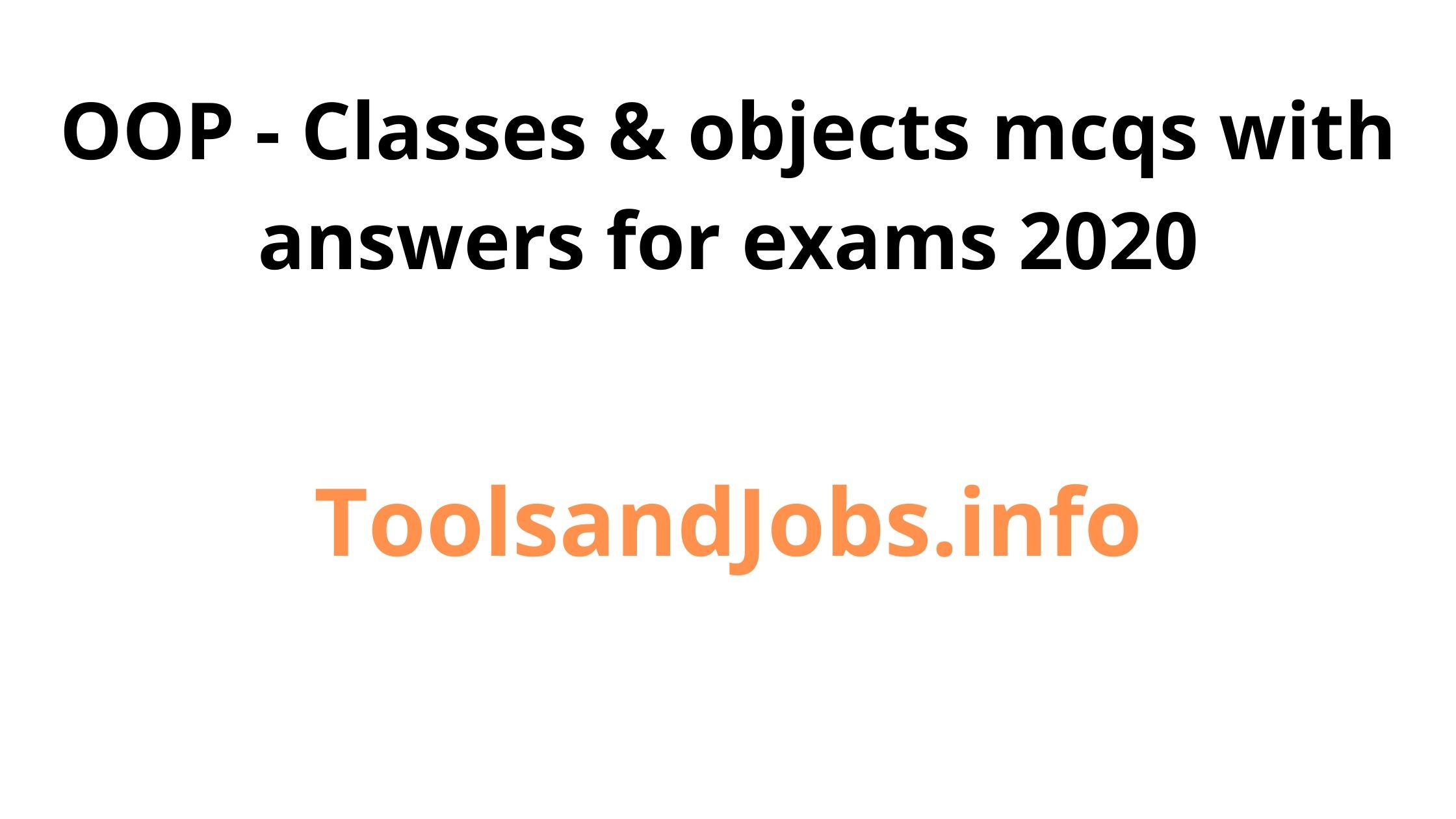Exception Handling MCQs In Object Oriented Programming Part 2. Most helps in placements, competitive exams and othe university exams 2020.
1 #include <iostream>
using namespace std;
int main()
{
int arr[] = {4, 5, 6, 7};
int *p = (arr + 1);
cout << *p;
return 0;
}
A 4
B 5
C 6
D 7
Answer B
2 #include <iostream>
using namespace std;
int main()
{
int arr[] = {4, 5, 6, 7};
int *p = (arr + 1);
cout << arr;
return 0;
}
A 4
B 5
C Address of arr
D 7
Answer C
3 #include <iostream>
using namespace std;
int main ()
{
int numbers[5];
int * p;
p = numbers; *p = 10;
p++; *p = 20;
p = &numbers[2]; *p = 30;
p = numbers + 3; *p = 40;
p = numbers; *(p + 4) = 50;
for (int n = 0; n < 5; n++)
cout << numbers[n] << ",";
return 0;
}
A 10,20,30,40,50,
B 1020304050
C Compile time error
D Runtime error
Answer A
4 #include <iostream>
using namespace std;
int main()
{
int arr[] = {4, 5, 6, 7};
int *p = (arr + 1);
cout << *arr + 9;
return 0;
}
A 12
B 5
C 13
D Error
Answer C
5 A void pointer cannot point to which of these?
A methods in c++
B class member in c++
C all of the mentioned
D None
Answer D
6 #include <iostream>
using namespace std;
int func(void *Ptr);
int main()
{
char *Str = "abcdefghij";
func(Str);
return 0;
}
int func(void *Ptr)
{
cout << Ptr;
return 0;
}
A abcdefghij
B address of string “abcdefghij”
C Compile time
D Run time error
Answer B
7 #include <iostream>
using namespace std;
int main()
{
int *p;
void *vp;
if (vp == p);
cout << "equal";
return 0;
}
A Equal
B No output
C Compile time error
D Run time error
Answer A
8 #include <iostream>
using namespace std;
int main()
{
int n = 5;
void *p = &n;
int *pi = static_cast<int*>(p);
cout << *pi << endl;
return 0;
}
A 5
B 6
C Compile time error
D Run time error
Answer A
9 #include <iostream>
using namespace std;
int main()
{
int a = 5, c;
void *p = &a;
double b = 3.14;
p = &b;
c = a + b;
cout << c << '\n' << p;
return 0;
}
A 8, memory address
B 8.14
C memory address
D None
Answer A
10 What we can‟t do on a void pointer?
A pointer arithemetic
B pointer functions
C Both
D None
Answer A
11 Which value we cannot assign to reference?
A Integer
B Floating
C Unsigned
D Null
Answer D
12 #include <iostream>
using namespace std;
int main()
{
int a = 9;
int & aref = a;
a++;
cout << "The value of a is " << aref;
return 0;
}
A 9
B 10
C 11
D Error
Answer B
13 #include <iostream>
using namespace std;
void print (char * a)
{
cout << a << endl;
}
int main ()
{
const char * a = "Hello world";
print(const_cast<char *> (a) );
return 0;
}
A Hello world
B Hello
C World
D Compile time error
Answer A
14 Identify the correct sentence regarding inequality between reference and pointer.
A we can not create the array of reference.
B we can create the Array of reference.
C we can use reference to reference.
D None
Answer A
15 Which is used to tell the computer that where a pointer is pointing to?
A Dereference
B Reference
C heap operations
D None
Answer A
16 #include <iostream>
using namespace std;
int main()
{
int x;
int *p;
x = 5;
p = &x;
cout << *p;
return 0;
}
A 5
B 10
C Memory address
D None
Answer A
17 #include <iostream>
using namespace std;
int main()
{
int x = 9;
int* p = &x;
cout << sizeof(p);
return 0;
}
A 4
B 2
C Depends on compiler
D None
Answer C
18 #include <iostream>
using namespace std;
int main()
{
double arr[] = {5.0, 6.0, 7.0, 8.0};
double *p = (arr+2);
cout << *p << endl;
cout << arr << endl;
cout << *(arr+3) << endl;
cout << *(arr) << endl;
cout << *arr+9 << endl;
return 0;
}
A 7
0xbf99fc98
8
5
14
B 7
8
0xbf99fc98
5
14
C 0xbf99fc98
D None
Answer A
19 What does the dereference operator will return?
A rvalue equivalent to the value at the pointer address.
B lvalue equivalent to the value at the pointer address.
C it will return nothing
D None
Answer B
20 Which operator is used in pointer to member function?
A .*
B ->*
C Both a &b
D None
Answer C
21 #include <iostream>
using namespace std;
class Foo
{
public:
Foo(int i = 0){ _i = i;}
void f()
{
cout << "Executed"<<endl;
}
private:
int _i;
};
int main()
{
Foo *p = 0;
p -> f();
}
A Executed
B Error
C Run time error
D None
Answer A
22 Which is the best design choice for using pointer to member function?
A Interface
B Class
C Structure
D None
Answer A
23 Virtual functions allow you to
A create an array of type pointer-to-base class that can hold pointers to derived classes.
B create functions that can never be accessed.
C group objects of different classes so they can all be accessed by the same function code.
D use the same function call to execute member functions of objects from different classes.
Answer D
24 A pointer to a base class can point to objects of a derived class.
A TRUE
B FALSE
Answer A
25 A pure virtual function is a virtual function that
A causes its class to be abstract.
B returns nothing.
C is used in a base class.
D A and C
Answer D
26 An abstract class is useful when
A no classes should be derived from it.
B there are multiple paths from one derived class to another.
C no objects should be instantiated from it.
D you want to defer the declaration of the class.
Answer C
27 A friendfunction can access a class‟s private data without being a member of the class.
A TRUE
B FALSE
Answer A
28 A friend function can be used to
A mediate arguments between classes.
B increase the versatility of an overloaded operator.
C allow access to an unrelated class.
D B and C
Answer D
29 The keyword friend appears in
A the class allowing access to another class.
B the private section of a class.
C the public section of a class.
D All of the above
Answer D
30 A static function
A should be called when an object is destroyed.
B is closely connected to an individual object of a class.
C can be called using the class name and function name.
D is used when a dummy object must be created.
Answer C


